SKY RAMP TECHNOLOGY
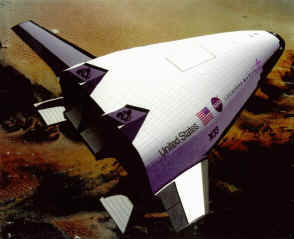 NASA research produced the X-33 design (right), yet few people understand the
simple concepts involved. An RLV needs an aerodynamic and compact shape, just like a
missile. However, since an RLV must fly home to land, it must glide on air, which
is best done with a "lifting body." The
best known lifting body is found in the B-2 bomber
(below). Its body is so wide that it
serves as a wing.
NASA research produced the X-33 design (right), yet few people understand the
simple concepts involved. An RLV needs an aerodynamic and compact shape, just like a
missile. However, since an RLV must fly home to land, it must glide on air, which
is best done with a "lifting body." The
best known lifting body is found in the B-2 bomber
(below). Its body is so wide that it
serves as a wing.
However, an RLV must carry far more fuel than
an aircraft. Since around 80% of its mass at take-off is fuel (actually
fuel and LOX, known as propellant) it must be fatter
than the B-2. If made sleek and pointy to minimize aerodynamic drag, it
must be twice as long to carry as much propellant, making it much heavier.
However, a B-2 cannot even fly Mach, while an RLV needs to
withstand air resistance up to Mach 3 until it leaves the Earth's dense lower atmosphere.
As a result, it must be more "swept back", like a missile. NASA
developed the X-33 as the ideal RLV shape; a compromise between minimizing both
air resistance and total surface area. Basically, it's a triangular gas tank
that must be rocketed into Space, then can glide home
empty using its lifting body and small stub wings.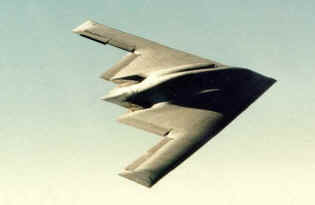
The X-33 or any RLV cannot fly like an aircraft when loaded with propellant. This is what most amateur spacecraft designers fail to understand, which includes many aircraft experts and executives at aerospace corporations. The chart below demonstrates this. Notice the X-33 and the 737 have nearly the same weight empty, however, the X-33 loads up with 211,000 lbs of propellant, while the 737 carries only 24,000 lbs. The X-33 has far less surface area for lift. Since the mass of an X-33 loaded for take-off is 77% propellant, it's like a triangular fuel tank. It would need wings nearly the size of a 747 to take off and fly, or to glide if towed by a 747. It could be towed through the air like an full water tank, bouncing and spinning and yanking the tow line, but this would be highly dangerous if not fatal, as NASA testing has shown when it towed old jet fighters.
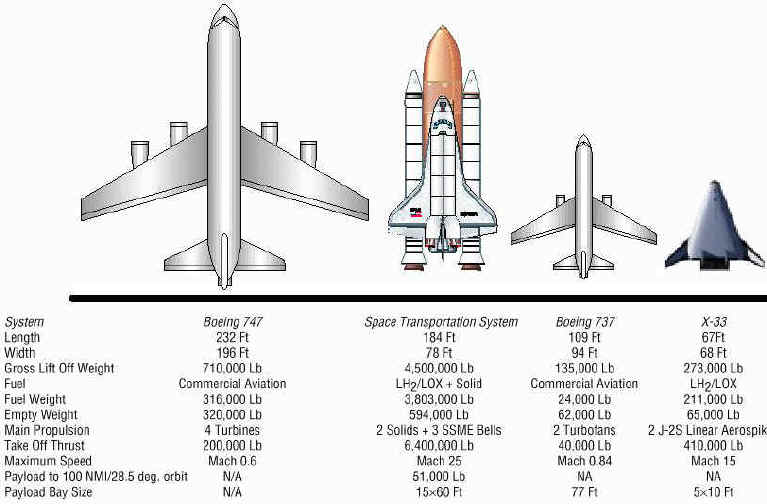
If an RLV is built like a 747, it will not be aerodynamic for high speed. The 747 is limited below Mach lest it break apart. Moreover, an RLV requires heat tiles on its underbelly to withstand the friction of reentry. Therefore, a 747-size spaceplane could take-off with the propellant needed for a small X-33, but it would need twice the rocket power to make orbit because its airframe is three times larger. However, it would then need even more propellant and more rocket power for that extra propellant, meaning an even larger aircraft. So the weight vs. thrust required problem grows until math proves the concept impossible.
A true spaceplane would resemble the aerodynamic
high-speed SR-71 (below) which can carry
80,000 lbs of fuel. If you swapped out the SR-71s jet engines for rocket
engines, you would need to make it much fatter to carry another 200,000 lbs of
propellant to make orbit. But then it would need much larger wings and larger
landing gear, and more rocket power and propellant for that added weight, and the
problem spirals. Keep in
mind that landing gear to support a fully fueled RLV "spaceplane" for
horizontal take-off must be five
times stronger than one to support it landing empty of propellant.
Keep in
mind that landing gear to support a fully fueled RLV "spaceplane" for
horizontal take-off must be five
times stronger than one to support it landing empty of propellant.
People are often confused by the Space Shuttle
design. The "orbiter" carries no propellant. The entire
system (orbiter, external propellant tank, and two solid rocket boosters) has a gross
take-off weight of 4,500,000 lbs, but delivers only 20,000 - 55,000 lbs of cargo
into low orbit. This
demonstrates how spacecraft barely make it into orbit, and why minimizing weight is critical. 
The X-33 is the optimal RLV shape and still requires a powerful assisted launch to make orbit. The future European spaceplane, called HOPPER (left) will use a miles long horizontal sled to get off the ground. Unless they discover the value of inclined Sky Ramps, it will be sub-orbital and can only launch a tiny internally carried rocket. Any single-stage RLV to orbit is not possible without assisted launch, and rocket sled assist has been proven. When people suggest heavy landing gear and large wings to allow a spaceplane or towed RLV to take-off, or even smaller wings and landing gear for "fly back boosters", they don't understand the added deadweight eliminates any chance of making orbit.
For an easy example, take a gas can and fill it with 77% water to represent a fully fueled RLV, and add another 10% to represent the rocket engine and payload weight. Use a hammer to form a "lifting body", then tow it with a rope from a car and see if it will fly. An RLV is not an aircraft, it cannot take-off horizontally or be safely towed by aircraft when loaded with enough propellant to rocket into orbit. It must be heaved into Space with brute force, which is only possible using rockets.
RLV Locomotive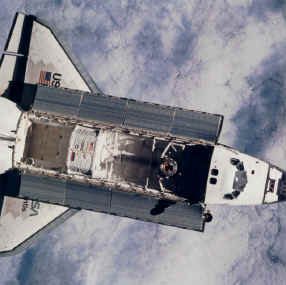
During the final months of the X-33/Venturestar program, the
LockMart team struggled to tweak a flawed SSTO RLV design. The
Venturestar team copied the Space Shuttle's internal bay. (right) LockMart engineers determined
that it could carry
much more propellant and simplify payload handling by moving payload outside the
RLV's body. (below) This also allowed different sizes of payload, or piggybacked vehicles. 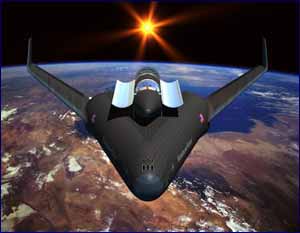
Putting the payload on the nose of the RLV
is better
since drag is reduced, but the Venturestar team didn't have the
funds or time for a major redesign. Future RLVs should adopt the idea that
an RLV need only act as a locomotive, and push payload into orbit, in the
same way expendable rockets push payload in fairings. This would not be a
pure RLV since the payload fairing (below) is expended, but this is a minor
expense that allows several major advantages: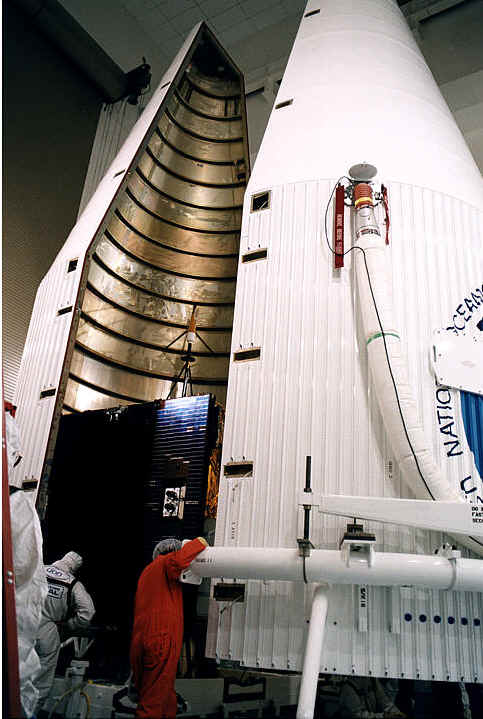
1) The RLV can carry more propellant.
2) Or, the RLV body can be smaller and more slender, reducing aerodynamic drag.
3) The RLV does not need a large mechanical arm to deploy payload into orbit.
4) Turnaround time is reduced since the next payload fairing is simply mounted on the RLV nose.
5) The RLV can use today's common and proven payload fairings.
6) The RLV can achieve higher orbit if smaller payloads are encased in smaller fairings.
7) The fairing can include a small rocket to boost smaller payloads to high orbit or into outer space, just like today's rockets.
8) Payload can be jettisoned during a launch abort. This is not possible with internal payload, and most engineers doubt that a design like the Space Shuttle can safely land after a launch abort with thousands of pounds of payload inside.
9) The RLV can instantly jettison a nose-mounted crew capsule during an abort, which can land safely using parachutes.
Thus, the RLV becomes a locomotive. A smaller craft with just engines and propellant, which pushes payload into Space.
RLV Water Landings
Landing an RLV on a runway is complex and
dangerous. Although the Shuttle lands like an airplane, it has no engine
power and must glide to a landing beginning in Space. It cannot select
cross runways to avoid cross winds, nor can it go around if the approach is bad,
or select another airstrip if the weather suddenly changes during the descent. This is why
NASA often chooses to land the Shuttle in California, where the dry lake bed at
Edwards AFB provides a large safety margin. NASA then spends a million
dollars to fly the Shuttle to Florida on the back of a custom-built 747 aircraft.
Another problem is that Shuttle launches and landings are often delayed because
of bad weather at the few alternative landing sites around the globe. 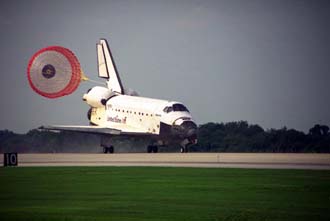
The Shuttle has never crashed landed, but of the 121 landings, two touched down short of the runway at Edwards, but landed safely on the dry lake bed. One touched down before the gear locked, and one had a tire blow out. The Shuttle must land at 220mph, much faster than aircraft, because it has small stub wings. NASA added a drag chute a few years ago to help slow and stabilize the Shuttle, but that added more deadweight. NASA provides details on how a Space Shuttle lands. Shuttle landings are considered risky, and no one at NASA will be surprised if a future Shuttle misses its approach and smashes into the ocean, or into the crowd of spectators at Kennedy.
As NASA studies a future manned spacecraft,
alternatives are under consideration. It may be possible to parachute land
an RLV, but an RLV is much larger than the small capsules of the Apollo era, so
the parachutes would be massive and deploying them tricky. NASA has
experimented with a new steerable parafoil design, (below) which slows the RLV
enough so it can land on simple skids. The X-38 parafoil tests were
successful, but this tiny craft required the largest parafoil ever built, which folded out in
sections.  This
seems promising, but deploying a massive parafoil may be dangerous and the
system would be large and heavy.
This
seems promising, but deploying a massive parafoil may be dangerous and the
system would be large and heavy.
Another option is water landings into a lake or bay, like a seaplane. Retractable landing gear needed for runways is complex, which increases chances of failure as they may be damaged by heat and air pressure changes, which dictates a redundant deployment system. Landing gear also uses up internal volume and is deadweight. The Shuttle's landing gear weighs 7000 lbs, for a spacecraft that puts just 50,000 lbs of payload into orbit. In addition, typical tricycle landing gear require an airframe reinforced to withstand the landing impact on just three points.
Another advantage is that water landings
allow emergency landings on 70% of the Earth's surface. This is key because
plans for Shuttle aborts are very dangerous and require luck to glide to an
alternative landing site. Launches are often delayed because of bad weather at
those sites. In addition, the Shuttle cannot abort until it reaches high
altitude in order to glide to a distant airfield. Finally, landing gear
requires landing gear doors on the RLV's underside, which must be covered with
heat resistant tiles. The landing gear system alone accounts for ~20% of
the production and maintenance cost of the Shuttle. For example, the
Shuttle uses custom-made tires filled with nitrogen, which are replaced after
each mission. 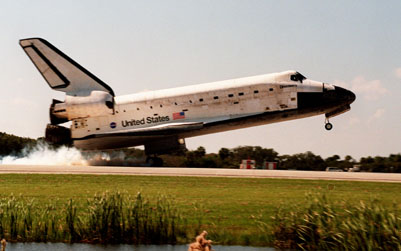
Seaplanes do not need landing gear, they land on their hull. The most modern RLV design, the X-33, uses a titanium lifting body which is already a boat hull shape. Water landing allows the underside of an RLV to be a smooth single piece with no doors, so no heat tile edges would exist, which cause minor aerodynamic friction. If the single piece titanium shield suffers minor burn damage during reentry, it can be quickly replaced, compared to the weeks now needed to inspect hundreds of small Shuttle tiles.
An RLV capable of landing on water would fly over hundreds of alternative landing sites and it crosses the USA to land in Florida. It could slowly turn to adjust for winds as it descends from any direction. Since it would not require landing on an exact spot like the Shuttle, it could have a smaller tail to reduce deadweight and drag. Within a few feet of the water's surface, a drag chute opens to slow the RLV and prevent it from "fishtailing." After coming to a halt, a tugboat can tow the RLV to a pier where it can be lifted out of the water with a crane, or pulled up a ramp and onto a huge trailer, just like a motorboat.
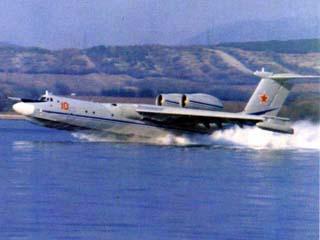 There are ideal water landing sites
adjacent to the Kennedy Space Center; the Indian River and the Misquito Lagoon.
NASA may choose to build a huge runway-size rectangular pool on land for the
RLV. The Russians operate several types of fast-landing jet powered
seaplanes. (left) They designed a water landed spacecraft
in the 1950s, but it was never built. Spacecraft designers emphasize
safety and simplicity; there is no doubt that a water landed RLV is much safer
and simpler than using heavy and complex landing gear that requires a
long, hard runway. Hopefully, NASA will evaluate this weight saving
alternative as it seeks new ideas for future manned space flight.
There are ideal water landing sites
adjacent to the Kennedy Space Center; the Indian River and the Misquito Lagoon.
NASA may choose to build a huge runway-size rectangular pool on land for the
RLV. The Russians operate several types of fast-landing jet powered
seaplanes. (left) They designed a water landed spacecraft
in the 1950s, but it was never built. Spacecraft designers emphasize
safety and simplicity; there is no doubt that a water landed RLV is much safer
and simpler than using heavy and complex landing gear that requires a
long, hard runway. Hopefully, NASA will evaluate this weight saving
alternative as it seeks new ideas for future manned space flight.
Smaller Skyramp
The X-33 section provides the calculations to show how the X-33/Venturestar design could make orbit if launched at Mach 2 off a 2.5 mile long inclined Sky Ramp. If a similar RLV is designed as a locomotive without a payload bay, it can have a more slender body or carry more propellant. If the heavy internal landing gear is eliminated in favor of water landing, much empty weight is saved and the RLV can be smaller, or carry more propellant. Finally, launching off a ramp at over 12,000 feet means much less air resistance and greater engine efficiency due to better rocket plume. (see High Altitude Launch section.)
A new RLV SSTO program could simply modify the Venturestar design to push payload into orbit by using an expendable fairing. The internal space saved from the payload bay and landing gear allow for a smaller size or more propellant. The original aerospike engines can be replaced with lighter traditional engines that produce the optimum plume at higher altitude when rockets fire after a Sky Ramp launch. All of these factors allow an RLV to make orbit after an assisted launch from a much shorter inclined track and a velocity of around mach. This makes Sky Ramp construction and operations less costly and less complex.
©2009 Sky Ramp Technology